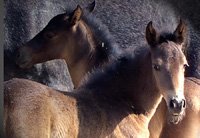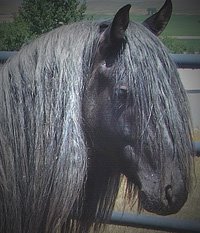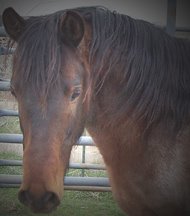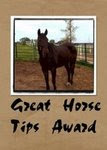Aaruba's Equine Gastric Ulcer Syndrome (EGUS) has cost me over $2,000 over the past two months. Endoscopy, GastroGard, sucralfate, extra feed, more GastroGard, Doxycycline, ulcer supplements... Expensive horse, indeed.
Sadly, Aaruba's condition is not unusual. Evidence abounds that at least 60% of performance horses across the spectrum of breeds and disciplines suffer from some degree of gastric ulceration. Many cases are asymptomatic, others manifest themselves in subtle shifts in performance or behavior, and some go so far as to cause anorexia and recurrent, mild colic.
Trust me, you don't want to go through ulcer treatments for your horse if you can avoid it. If you've already been through treatment, you most certainly don't want to do it over. So, what strategies can you apply to prevent equine gastric ulcer formation or recurrence?
 Free feed hay: An empty stomach is an acidic stomach, and an acidic stomach is prone to ulceration. Horses on pasture or allowed unlimited access to grass hay are at lower risk.
Free feed hay: An empty stomach is an acidic stomach, and an acidic stomach is prone to ulceration. Horses on pasture or allowed unlimited access to grass hay are at lower risk.
Limit or eliminate grain in the diet: Grain promotes the production of the hormone gastrin, which in turn stimulates increased production of stomach acid. Research indicates that the bacterial fermentation of concentrated carbohydrates releases volatile fatty acids that contribute to rapid ulcer formation. Additionally, horses produce less saliva when eating grain when eating hay; this is significant because saliva works to neutralize stomach acid. Some experts recommend that, if you must feed grain, quantities be limited to one pound per feeding; ideally, the calories your horse currently receives from grain should be replaced with fats such as corn oil.
Similarly, don’t make a practice of feeding soaked hay: A horse consuming soaked hay doesn’t need to produce as much acid-buffering saliva as a horse consuming dry hay, and therefore has a more acidic gastric environment.
Include alfalfa in the diet: Alfalfa’s calcium content acts as a buffering agent in the stomach. Unfortunately, excess calcium is also associated with synchronous diaphragmatic flutter, or “thumps,” during protracted exercise. Furthermore, alfalfa has a high protein content (up to 20% or more), and excess protein is known to increase risk of metabolic problems such as azoturia, or “tying-up syndrome.” For these reasons, endurance riders must balance the risks and benefits of feeding alfalfa, taking steps to balance the diet appropriately. In most cases, two or three pounds of alfalfa hay daily is acceptable.
Avoid exercising a horse on an empty stomach: The upper, non-glandular portion of a horse’s stomach does not produce acid and is not meant to contain acid; it lacks the protective coating that is present in the lower, glandular portion of the stomach. Experiments using an endoscope demonstrate that exercise on an empty stomach allows acid from the glandular portion of the stomach to splash the non-glandular portion, contributing to ulceration. The presence of food in the stomach creates a floating mat or paste that reduces splashing and resultant irritation.
Avoid long-term or frequent NSAID use, if possible: Nonsteroidal anti-inflammatory drugs (NSAIDs) such as phenylbutazone (bute) and flunixin meglumine (banamine) block production of the prostaglandin PgE2, resulting in decreased blood circulation to the stomach and increased gastric acid production. Interestingly, ulcers caused by NSAID use tend to appear in the lower, glandular portion of the stomach rather than in the upper, non-glandular portion where ulcers related to athletic effort generally develop.
Consider preventatives: When your horse faces a stressful situation, such as trailering or competition, you may wish to administer preventatives such as UlcerGard (omeprezole) or an antacid. When selecting a preventative, be mindful of drug policies; some sanctioning bodies prohibit the use of common ulcer preventatives.
Reduce stress: EGUS appears to be largely a man-made condition. A horse on the range, left to its own devices regarding shelter, feeding habits, and exercise, is highly unlikely to develop ulcers. Unfortunately, such a life is impractical for the vast majority of domestic horses. It is our responsibility as horse owners, however, to mimic as closely as possible the lives our horses are designed to lead. Minimize stalling, maximize turnout, allow constant access to hay or pasture, respect your horse's innate need for equine companionship. Know your horse as an individual, and go out of your way to make his life easier. His stomach will thank you.
Despite our best efforts, some horses will still suffer from gastric ulceration. The next post in this series will examine treatment options for curing existing ulcers in adult horses.
______________________________________________
Related Posts
Introduction: Equine Gastric Ulcer SeriesPharmaceutical and Alternative Treatment Options for Equine Gastric Ulcer Syndrome
Equine Ulcer Supplement Options
EGUS, Endurance, and the AERC
A Fair Question: Equine Athletes, Equine Ulcers
Bringing it Home: EGUS Prevention at In the Night Farm
Sheer Brilliance: Aloe and MSM as Alternative Therapy for EGUS
Q & A: Aloe and MSM as Alternative Therapy for EGUS
The Good Bad News: Gastric Ulcers in Equines
______________________________________________
Was this post useful to you?
Subscribe to The Barb Wire









2 comments:
This was an excellent post....very informative... I'm very sorry to hear that your horse is going through this.
A few months ago, a friend had to put down her 18h Anglo-Trak. after he had been through several bouts with ulcers. Her vet bills were also astronomical. She, like you, was very knowledgeable and did everything that was humanly possible. In the end, it was colic.
I so agree with what you said about the things you can do for prevention...too many horses are not turned out the way the should be. Many people who board horses have no clue as to what they are being fed. And aside from this...I'd say that 85% or more do not have a clue about fitting a saddle.
Lori Skoog
Hi Lori. Yes, the bills for ulcer treatments do add up. Sorry about your friend's horse. :-( Do you know if the vets thought the colic was ulcer related (typically, the colic symptoms associated with ulcers are mild and due only to ulcer pain -- no impaction, twist, etc.)
No kidding about saddle fit! Out riding around here, I'm appalled by the number of horses with white spots on their withers from ill-fitting saddles.
Post a Comment